Teacher as facilitator: how to improve your lessons with facilitation
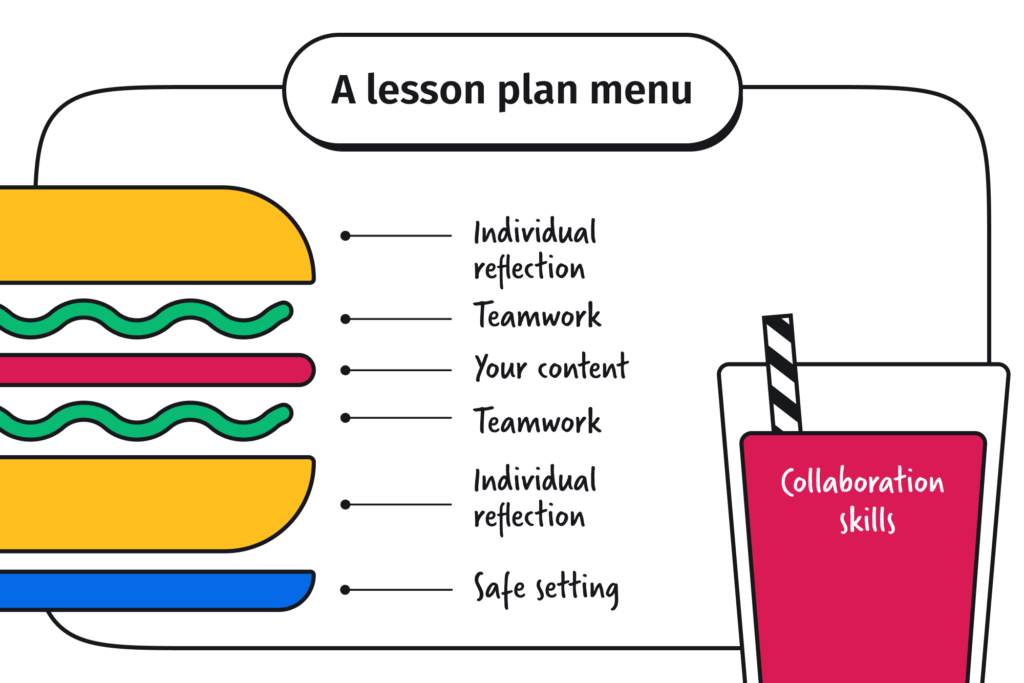
There is a lot of overlap between education practices such as the “flipped classroom”, direct education, participatory learning, and facilitation. Building relationships, exploring topics creatively, and, of course, asking questions together you are probably doing something akin to facilitation in the classroom already.
In this article we will explore what educators can learn from facilitators: insights, best practices and activities you can run in your classroom to boost engagement and collaboration! Facilitation might just be the source of insights, frameworks and ideas you are missing in your quest to make your lessons the best they can be.
In the following paragraphs, we will look at:
What is facilitation in education
An effective facilitator leverages the power of a group to elevate its members so they can work at their best and obtain great results as a team. You can apply its mindset and skills to working with a class of students. Through the lens of facilitation, a class is a group with the specific objective of learning together.
Using facilitation in education settings means focussing on practices that improve group collaboration and use the group’s collective energy to support individual learning. It means paying attention not only to what you are teaching but especially to how you are working with students to create a positive learning environment with lots of active participation.
Why use facilitation in the classroom
The ability to facilitate and, even more so, to share facilitation tools with your students can help solve some common challenges that come up when you teach, such as:
- keeping engagement and participation high; from energizers to playful toolkits, facilitators know a lot about how to keep learners active throughout long workshops;
- preventing difficult classroom dynamics. Facilitation can really help with conflict prevention, by creating welcoming learning spaces where differences are leveraged to everyone’s benefit and the rules of engagement are co-created and clear;
- designing memorable lesson plans; facilitators are great designers and can share plenty of tips on how to create agendas that work;
- developing facilitation practices in class can help equip students with real-world skills in teamwork, listening, communication, problem-solving, strategic planning and collaboration they are going to need in the workplace (their future colleagues will have you to thank!).
As you may have already realized by now, facilitation is especially easy to pair with teaching methods that are already student-centered, such as flipped classrooms, direct education and other active learning strategies. Indeed there is quite a lot of overlap between these frameworks and a facilitative approach.
Teaching vs facilitation
Teachers cannot be “pure” facilitators though, and it’s important to make sure we are clear on the difference between those roles. A facilitator is not a content provider: she brings activities and processes to groups but lets them set their own targets and find their own solutions. This approach can be applied in certain classroom situations, for example, to help students get to know each other and intentionally create their own “classroom culture”, but cannot be used at all times.
A facilitator’s objective is to support the group’s journey, but a teacher has other important roles to keep in mind such as, first and foremost, providing information and content to their students. The type of authority wielded by a teacher, who may be grading papers next week, and by a facilitator, who does not evaluate participants’ performances (actually, he might be the one getting an evaluation at the end of a workshop!), is also different.
Depending on the type of learning institution you are in, this probably means keeping close at heart the idea that teaching remains your primary role and skillset, with facilitation a helpful “extra” piece that can really make the difference in transforming your lessons into more participatory and rewarding experiences!
Facilitation skills for teachers
Facilitators have developed skills specific to working with groups which can be useful for teachers as well. The needs and challenges of facilitators and teachers are quite similar, but since teachers’ training is usually more focused on content, some insights from those who spend their time working on process might come in handy.
Some of the facilitation skills that overlap with teaching are:
Let’s go a bit deeper in each of those and see what teachers can learn from facilitators on these topics!
Moderation
Facilitators have developed a series of tactics and tools to improve the flow of conversations. Tools such as using a talking piece or speaking in a round can help make sure everyone has a voice. Positive reinforcement, which of course many teachers already master, is used in facilitation to ensure quieter participants feel heard and grow in confidence that their opinions are valued.
In classrooms as in board rooms, it’s sadly common for a few voices to dominate the conversation. Help learners understand that building upon one another’s opinion is more fun and interesting than “survival of the loudest” with facilitation games and exercises to boost collaboration.
My mediation teachers say that humans often tend to shout louder when we feel there is more distance between us. If we are physically distant from one another we need to raise our voices to bridge that gap, and we tend to apply the same mechanism to psychological distance. Wanting to be heard, we raise our voices. But as you’ve probably experienced, raising our voices to be heard is a strategy that does not always work, neither for students nor for teachers!
Argumentative discussions and arguments that get louder and louder can signify an unmet need to be heard. And so can giving up and getting extra-quiet. Creating a more inclusive learning environment where students feel comfortable expressing their opinions and hearing that they are valued can do a lot to defuse tensions and prevent classroom conflict.
Creating an inclusive learning environment
In many schools across the world, diversity is increasing and, sometimes, is seen as a challenge to the flow of learning, exemplified by the idea, still commonly held, that students need to learn a new language before fully participating in classroom activities. That is part of the story, but a facilitation mindset that sees diversity as a gift can be a good lens through which to develop some new classroom management ideas.
Skilled facilitators celebrate diversity and do not shy away from underlining how differences can be enriching for the entire conversation. Teachers as facilitators might use similar approaches by asking students to present stories that display their differences in a positive light and discussing these with the class.
Asked to facilitate a welcoming day for a new cohort of first-year University students I once asked them to share (first in pairs and if they wanted to with the whole group) stories about their ancestry. To me as a facilitator, this was a simple, quite basic getting-to-know-you idea, but students later came up to me to say it had made all the difference, as they no longer felt they needed to hide and conform, but could bring their whole selves (and later in the year, some pretty amazing Indian dance moves) to the course!
Awareness of group dynamics
A useful area for teachers to explore is understanding group dynamics and how they might influence effective learning. The classic model of team formation developed by Bruce Tuckman can be illuminating if applied to education. Facilitators know that teams must “form” and “norm” (and sometimes even “storm”) before they can “perform.” Applied to education, this means that before we can learn we need to know the other people in the room, feel safe in the space, and understand what is expected from us and how to behave within a certain group.
Note that this process of, in effect, creating group norms and a group culture, will take place independently of whether you facilitate it or not: it’s simply the way humans, being social animals, tend to behave. Teachers as facilitators can harness the way this process works to raise students’ ambitions and help the class become a better version of itself.
This sounds like a lofty ideal but can easily be facilitated by running activities as soon as the class first meets in which students are encouraged to know one another, share something personal, and discuss together what they hope to achieve during the year or course. Who do we really want to be as a learning group? What will help you learn well, and show up at your best every day? What is harder? What we do to support one another when things get tough? In the absence of such prompts and a safe space to discuss them, it’s easier for the group to fall into trite patterns (unfortunately, very much modeled in society) of power over, bullying, and cynicism.
Agenda design
Facilitation emphasizes the importance of good planning and foresight. Before a workshop or event, a skilled facilitator will have a detailed agenda which reads a bit like a script of what the day will look like. This might sound like a contradiction with respect to the ability to sense group dynamics and change course accordingly, but we know the best plans exist in order to be changed along the way!
Designing agendas is a practical facilitation skill that can be applied to improving your lesson plans. Start with your desired outcome for the lesson: what are your objectives? Make your lesson “stripy” by combining different sorts of activities such as individual reflection, teamwork, and lectures. Design a flow that is appropriate for your group; since bringing back focus and quiet can be tricky in the classroom, you might want to move from individual reflection to a group discussion in steps, as in this example of a lesson plan template.
Trust and curiosity
If you think back at your own favorite teachers throughout your education, what did they have in common? The best educators, and the best facilitators, come from a position of trust and curiosity. They can imagine “the best possible emerging future” for this group, and suggest ways to move towards it.
A public participatory method I have used with neighborhood groups called Oasis Game has a whole section dedicated to using an appreciative gaze to find “points of light”: even in the most difficult living situations, what is there that expresses hope and beauty? And how can we build on that to make the whole neighborhood better?
Appreciative Inquiry is a framework based on the same concept of focusing on the positive, working with what teams are already competent in, and using those “native” capacities to face new challenges. It is not about running away from what is not working, but rather about reframing our orientation from problem-focused to possibility-focused. Trust and curiosity are core elements of the facilitation mindset which are also very much alive in the best teachers, and in the best teacher that lives within us all!
How to use facilitation in the classroom
Now that we are clear about the principles and reasons behind using facilitation in education, let’s take a look at what techniques and methods you may want to introduce in your lesson plans.
There are four main areas of the learning experience that can definitely benefit from adding facilitation skills to the mix! Starting from those more focused on the individual student and moving to those that harness the whole group’s energy, we will look into:
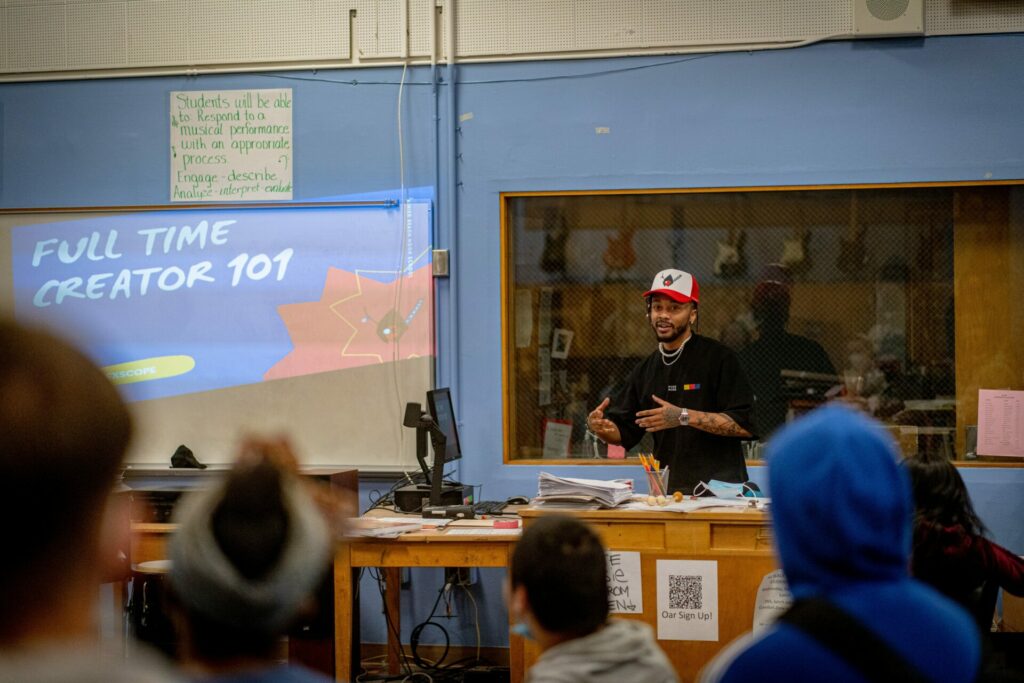
Using facilitation tools to increase motivation and active participation
As teachers and professors you, of course, retain a focus on content. It’s important to transmit concepts, information, and your expertise to students. But have you ever asked “any questions?” at the end of a painstakingly prepared presentation, only to be met with a wall of blank stares? That does not feel good, nor does it give you any insight in how students may actually have experienced your session. Maybe they are deeply reflecting, maybe they are completely distracted, and you have no way of knowing! And it just gets worse online, especially if webcams are turned off.
For six summers, I facilitated and coached teams of Masters’ students in the ClimateKIC’s Climate Innovation and Leadership summer schools. Our students would regularly flood lecturers from the host university with all sorts of questions, and interactions would be lengthy and lively.
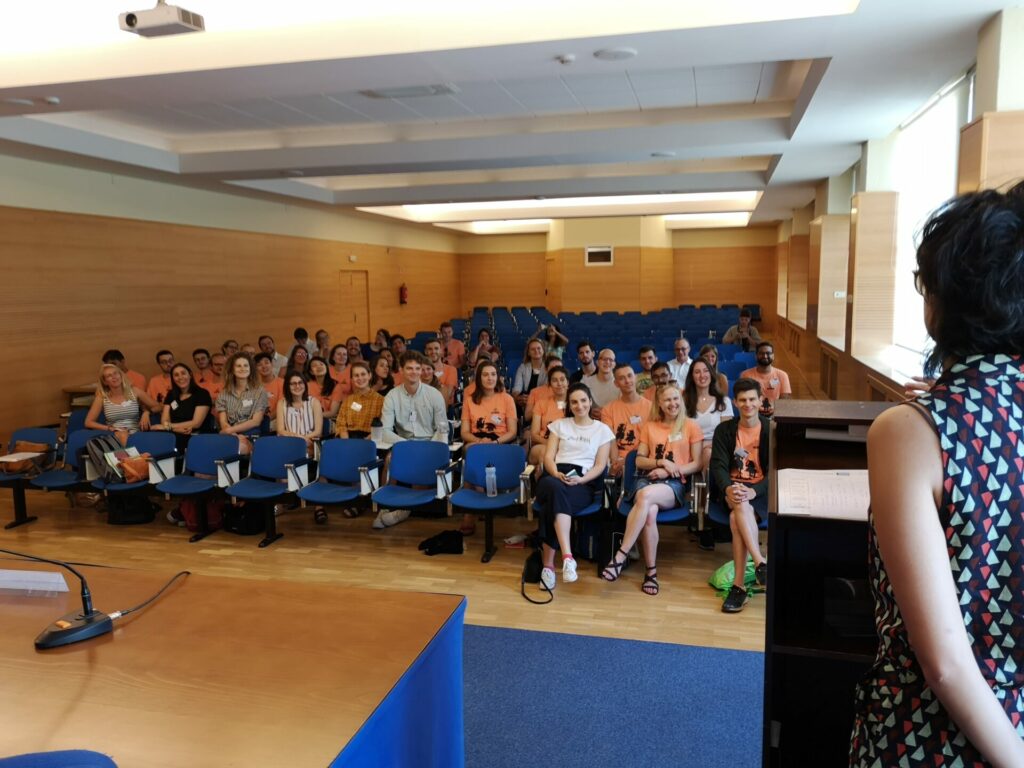
Sometimes, the professors would come up to me afterward to compliment us on having “picked and selected such a talkative and engaged cohort of people.” This was nice of them to say, and there certainly was an element of pre-selection (and self-selection, as not all students in the world are keen to spend their summers in lecture halls!) at work to justify why these groups were so active. But that certainly was not the only reason!
Here are three strategies we applied as classroom facilitators that worked to improve engagement and participation of learners, resulting in those lively Q&A sessions:
- We had set “group agreements” with the class, and one of those inevitably revolved around the topic of “it’s ok to ask questions, even if you think they are ‘stupid’ questions”.
In every set of students I ever set group agreements with, there was a moment, when someone confessed to feeling “dumb” when asking questions. The reaction from other students was always one of great relief: “Me too!” “Oh, me too!” and the agreement to be ok with asking questions, including so-called “stupid questions” was always deeply welcomed; - Before each lecture, we ran preparatory activities around personal motivation: why are you interested in this topic? Say you are not really, what angle or connection to another subject might interest you?
- Students, divided into teams, had afternoon group work on practical projects and challenges and were expected to find ways to connect information provided in morning lectures to real-life situations.
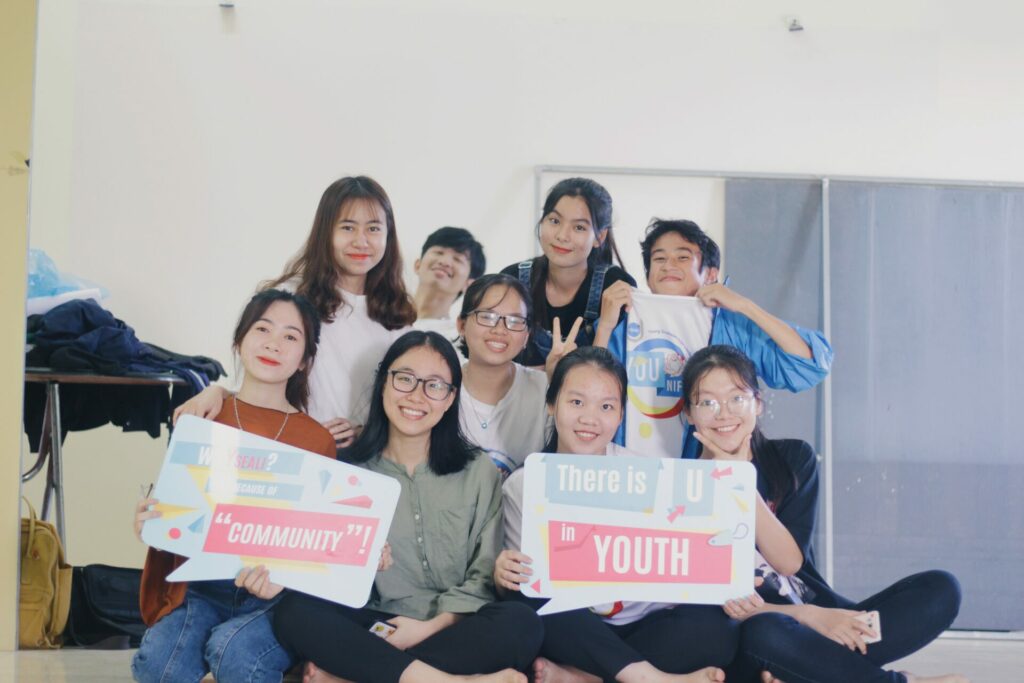
Generally speaking, facilitators work with adults and youth rather than with kids and preteens; many facilitation and training principles are therefore derived from knowledge related to adult education. Facilitators and trainers put in practice such tenets of adult education as “adult learners need a varied approach” and “engage adult learners with real-life case studies”. Here are some of the things facilitators do that can help you increase engagement and motivation in the classroom:
- Setting individual goals and intentions. Before introducing a new subject, invite students to reflect individually and write down what they want to learn, what they may find interesting and why.
It’s important to underline that such “learning journals” should be kept personal, or shared only if students wish to, and not be subject to grading! If you want to add an extra level of accountability, you can inform students that at the end of the course or learning module they will be asked to turn in a short reflection on their learning journey, based on their learning journal. - Varying styles and activities. Facilitators know that attention spans are short (and getting shorter!) and keep things moving by mixing and matching different styles and types of activities. Combine moments of individual reflection, play and creativity, group work and lectures. Use direct/active education practices that engage the senses (and not only with children!).
Facilitation techniques that assist students in their individual learning
A skilled workshop facilitator leverages participants’ different learning styles to create as many opportunities as possible for “a-ha” moments in which participants suddenly grasp new knowledge or a new idea. Inspired by this approach, teachers can draw from facilitation principles and activities to support their students in integrating, understanding and digesting information from their lessons.
Whatever their particular field, trainers and facilitators always include a debrief section to activities. This is an opportunity for participants to reflect on their experiences or on the content presented, mull it over, discuss, draw their own conclusions. You shouldn’t discredit any of the theories presented, no matter how fantastical, but you can gently steer towards discussing the key points and findings you want to make sure your learners understand.
Some of the facilitation activities you can use to help students integrate new concepts in their learning when you teach include:
- 1-2-4-all. Use this well-honed facilitation activity to guide reflection after delivering content. Ask students to write down individually, then in pairs, then in small groups and finally to the whole class what they have learned today.
- World café. Prepare three key questions that might arise from your content and place them on flipcharts in three corners of the class. Ask students to discuss the questions in small groups and change table every few minutes.
- Sticky notes wall. As students leave the room, ask them to add a sticky note to a poster with a question about “What have you learned today?” “What questions are you left with?” Allow for anonymous contributions, and you can prepare your next lesson based on the notes you gather.
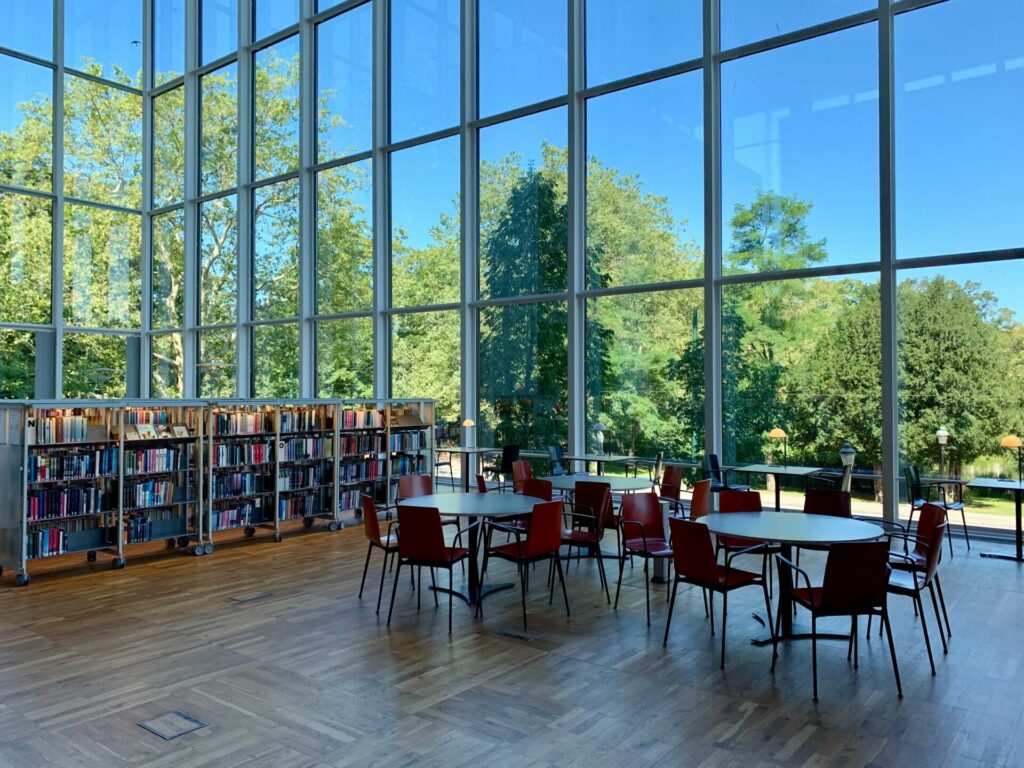
Facilitated activities that boost classroom cohesion
“Who am I in this group?” is a participant’s preoccupying question as any learning convenes, and there’s limited capacity for learning anything else until this question is answered. These are the wise words at the start of my top-one recommended book for applying facilitation to the classroom, George Lakey’s Facilitating Group Learning – Strategies for Success with Diverse Adult Learners.
I have been shocked to discover, while running human rights workshops in high schools, how little students may know about one another, despite being in the same classroom every morning for months! As facilitators, we assume that deeper, more personal knowledge of one another goes very far to build a positive learning environment; facilitation tools can be particularly useful when beginning to work with a new class of students at the beginning of a course or of the school year.
Getting-to-know you activities and games are how I generally begin the first day of courses I tutor with University students. I aim to keep it light but also challenge students to go a bit deeper, putting them in pairs or small groups of 3-4 (less intimidating!) to answer some personal questions, pointing out they can choose to go as deep or stay as generic as they feel comfortable, and that they will not have to share with the big group unless they want to.
Facilitation can also help create a sense of group identity within the class. Activities such as creating group agreements, a group motto, poster or chant, can be semi-playful ways to discuss “who are we as a group” and raise aspirations to “who do we want to be?” A poster with key words, values and behaviors we want to hold to as a whole can be a great reminder of these discussions—and should always be co-created; it doesn’t work if it’s imposed by the teacher!
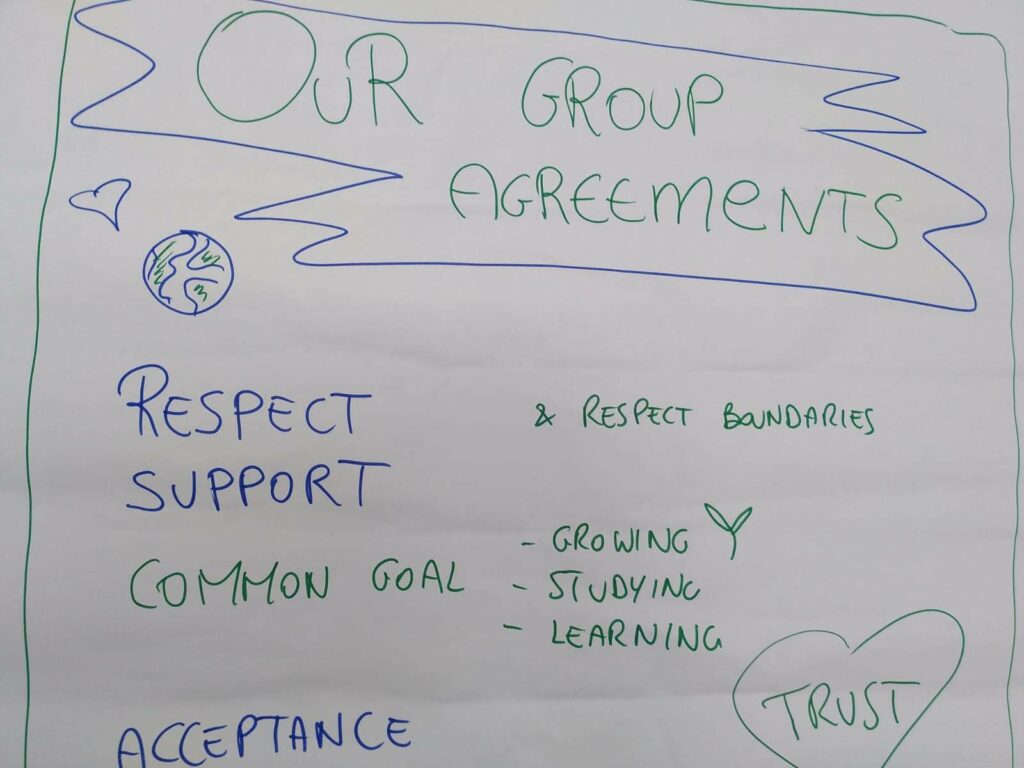
set with a class of Masters’ students in 2022
Give students the gift of collaboration and communication skills (they’ll thank you later)
Teamwork activities play a big part in education (more or less so depending on which part of the world you are in), with group assignments being a common part of every student’s life. As it should be: to prepare young ones for future tasks in life and work, knowing how to work with others and reach common targets effectively is key!
Yet, many students lament the experience of being thrown into group work with little or no instructions on how to work together. The resulting dynamics mirror all the dysfunctions teams encounter when collaboration just isn’t that great: the most driven students take on all the work, with the others just tagging along for the ride. It may be easy to empathize with those working hardest, but the ones left behind might be suffering as well, feeling perhaps that they were not given a say in the task. This lack of shared ownership is a common pattern in school as well as in team and office work.
Facilitation can help to improve shared ownership of projects, create understanding and keep all team members accountable. Share facilitation tools with your students early, when you are working on the first team project of the year. Before they get to work on the content, ask them questions and give them canvases to help them reflect on how they want to work together. Yes, collaboration can be taught!
A big favorite with my students is I DO ARRT; it’s a basic mnemonic of what they should discuss before starting their teamwork. What is our Intention today? Where do we want to be with this project when the hour is over (Desired Outcome)? What willl we work on (Agenda)? Who will do what (Roles)? Do we need to set any Rules? And how much Time do we have? I DO ARRT works because it feels like a game: we set the rules together before getting down to work. It is also a repetitive structure students can then use at each team meeting or for each future project. When introducing new teamwork activities, a teacher working with her facilitator hat on might lead the groups in an intention-setting activity before starting. Ask each group to take turns in rounds discussing questions you’ll have provided, such as “What excites me about this project?” “What can I contribute?” “What helps me work well?” “How will we help each other get the tasks done?” Make sure each team member has time to speak and is actively involved; bring sticky notes and canvases to fill in with everyone’s answers.
When creating teams for group work, I also like to ask them to apply some creativity to creating their own group name and group cheer or greeting, and show it to all the others to big rounds of applause.
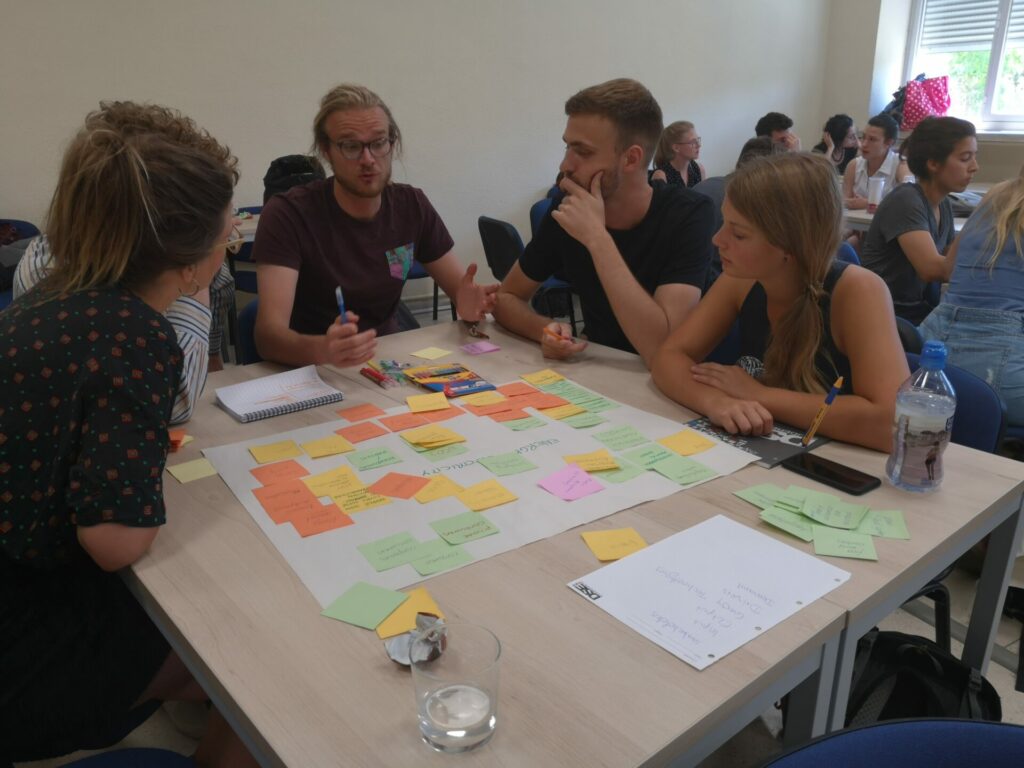
No information provided by the teacher or facilitator is as effective as information or knowledge shared among peers! Leverage this very human aspect of peer communication by having rounds of peer advice. After teams have worked together on a project, ask each group to share one tip they have for all the others: what is working well in our group that you might want to do as well? This kind of practice builds up confidence and collaboration skills in the entire class.
Feedback, I have found, is very very tricky to teach and use in school. I assume this is because many students are used to their work being graded (and would very much like the opportunity to grade someone else’s!). In many education systems, students may be more accustomed to criticism than to positive feedback. I have asked high school students to provide feedback to each other in groups after a workshop and was absolutely horrified when they took the opportunity to tear one another’s work down!
To avoid making my same mistake, make sure you use clear guidelines if you are asking students to provide feedback to one another. Structured sets of questions such as “What was one thing you really liked about the other team’s project?” and “What was one thing they could improve to get even better?” can help every person in the room practice the essential skill of giving and receiving feedback —- not an easy one at any age!
Creating better lesson plans with facilitation
A lot of the facilitation process has to do with crafting designs that lead participants into a learning journey. There is a lot teachers and educators can learn from the way workshop agendas are put together, that can help improve learning outcomes for your students. Some of these tips may be things you do already: interconnections among research into pedagogy, education, and facilitation are many!
- First of all, facilitators have an agenda! This may seem banal but as teaching is so focused on content, you may be tempted to work a lot on what you are going to say but less on how the hour or day will flow. That may translate into lessons that are rather unimaginative, and leave you more tired at the end!
- Set up each lesson as if it were a story, with a beginning, a middle, and a (satisfying) conclusion. When a lesson is cut short by the bell, that leaves ideas hanging in the air. Track time and make sure you have a few minutes at the end of each class to debrief, summarise and wrap up. And speaking of wraps…
- Facilitators make content sandwiches! Workshop agendas include sections that prepare participants to delve into an activity or a lecture, the activity itself, and a closing and debriefing part. We’ve prepared a handy visual you can print out and refer to when designing!
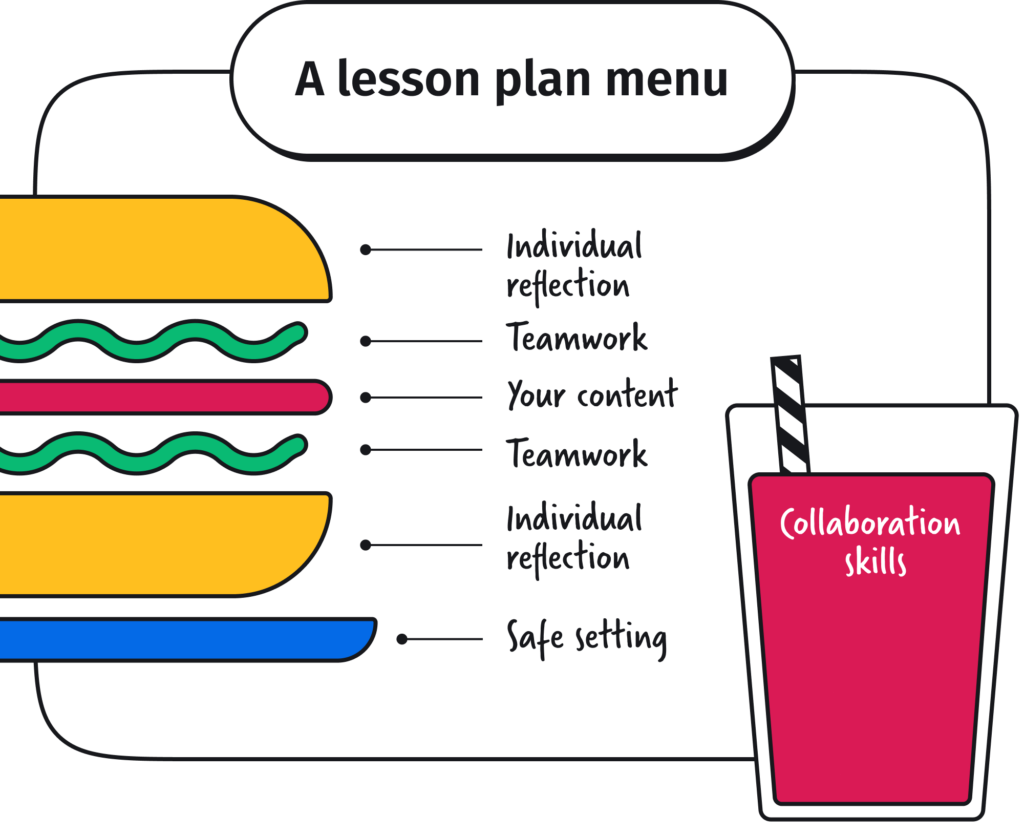
- Combine individual, group, and whole-class activities for best results. Any learner will find it easier to participate if you create different ways of doing so. Encouraging different ways of thinking, enabling reflection and boosting collaboration skills and problem-solving are just some of the benefits of this approach.
- Mix groups around. Some groups will resist this and try to default to the “I’m working with my best friends” mode. Break cliques up often, for example by creating groups at random and having students switch teams as much as you can. This approach may initially meet some resistance, but will do wonders to improve class-wide communication and cohesion. After all, in work and life, students will not always get to choose who they prefer to work with!
Looking for some more inspiration and examples of what a facilitated lesson plan would look like? Here is a 1-hour lesson plan you can check out and adapt to your own needs!
In this template, you’ll find a combination of reflection activities to prepare your students for learning, a section to facilitate engaging discussions, and space for your content as well. If getting students active is one of your objectives but you don’t know where to begin, take a look!
How facilitation can help make online education engaging
When classrooms and courses moved online due to Covid-19 lockdowns, I was one of the fortunate ones. I had been preparing a higher education (university-level) course which was funded well enough that before moving classes online me and the other tutors and instructors in our particular field had the privilege of getting specialized training in various topics.
We covered the basics of working with online tools as well as how to keep the class engaged with virtual energizers and Zoom-based improv games. I went from being a skeptic to believing that it is, indeed, possible to create meaningful, participatory learning online.
Sadly, not everyone had the luxury of top-notch tech and expert facilitator training, and I am well aware that being hurled into online learning was extremely difficult for most teachers and educators. Without good internet connections and decent equipment, I appreciate there was little to be done; it is also a completely different ballgame to be working with youth and adults with respect to kids!
So with those caveats in mind, I still feel it’s important to share the realization that, with the help of some facilitation tips & tricks, it is possible for any facilitator to create great online learning experiences.
Here are three ways that facilitation can help create great online education courses and classes:
(1) Cohort-based learning. Creating small groups of people who are going through a course together is a major booster for motivation. In my experience, this is also the best way to decrease drop-out rates. Having some facilitation skills will help you to set up cohorts, using insights from how facilitators create and support effective groups.
Place your students in small peer groups of about 7-9 participants. Aim to make the small groups self-managing as much as possible. Give them prompts and ideas of what to discuss, but also leave them free to explore materials and talk about personal matters if they feel like it: honest connections and interpersonal communication are valuable in and of themselves and can compensate for the isolation of learning online.
One way of setting up cohort-based learning is for the facilitator to be there at the peer group’s first session, set some ground rules and get everyone comfortable, then help them set times for their own online meetups (this is particularly likely in adult education; for example, it’s how Acumen Academy set up many of their courses).
In different setups, all your students may be attending at the same time. You can still enable cohort-based learning by placing them in breakout groups, always with the same people, and providing a template for an activity each time. Another good practice is to keep 10 minutes at the end of each session for these “home groups” to discuss and debrief the lesson.
(2) Keep the energy going. Use virtual energizers, small groups, and breaks to keep learners engaged throughout the class. We’ve seen how facilitators work to create agendas that cater to many different learning styles.
Effective online education works the same way, but you should introduce more breaks and find ways to encourage learners to look away from the screen and do something in the real world (and then come back to discuss it with you!). Read our guide to virtual facilitation for more tips on this topic.
(3) Don’t forget asynchronous communication. Facilitators know that a learning process begins from the first workshop invitation and ends long after the session is over! How to transfer this knowledge to an online classroom setting? Simply remember that caring for the relationship between you and your students is key, and can be done through emails, videos, quizzes, and any tool your creativity suggests.
Keep in touch with students, send them materials, ask them for feedback. This useful article from Edutopia has tips on what kind of questions to ask to get valuable feedback on your classes. You may, for example, invite the students themselves to come up with ideas to improve the way the class is interacting with technology.
If it’s possible for you (this varies a lot based on location, type of class, privacy issues) to create a group for students to chat on, consider doing it — some of the chat groups I set up are still active years later with participants exchanging resources, ideas and even job offers!
Facilitators also have a lot of expertise when it comes to including different types of participants in online settings. Just last week I attended a facilitated networking space for colleagues around the world; many came from countries with bad internet connections and were using their phones, with cameras off, to interact. The facilitators did a great job with inclusion by, among other things, using the chat space, and giving clear instructions as to how to ask for the floor in different ways.
Design for simplicity to make sure people with all sorts of challenges, be it neurodivergence or just a really shitty internet connection, can be involved in all activities.
For each lesson or practice, find different ways to communicate instructions (e.g. speaking them but also having them up to read on a slide, and/or sent to participants before the day of the class). Check-in with students to find out from them what kind of instruction they would like and what would work to make their interactions easier.

What to keep in mind when introducing facilitation in the classroom (with a real-life story)
My friend Hannah has been on my mind as I was preparing this article. A middle-school teacher and a facilitation enthusiast, she has been using workshop-friendly tools in her classes for years. Her students love it, but it was not always easy! When she began her career, as a substitute teacher, using facilitation tools such as active listening practices and group work backfired on her. Because I was the only teacher doing this kind of thing, she explained I suddenly was perceived as something like the class tutor or psychologist, and students were coming to me with all sorts of personal problems! This was outside my role, and I did not have the tools to cope with it… It was exhausting!
Hannah, like many newcomers to education, learned the hard way that it was very important to set boundaries and clarify limits. If you are working in a formal education system where students are evaluated based on their grades, for example, a more facilitative style could clash with your role as the person responsible for grading their work. You’ll need to find your own way to make this clear to students and make sure they understand that a facilitated class is not a permanent break, but is just as serious a as a formal lecture… just in a different way!
Early on I tried to re-energize the class by asking everyone to change seats, Hannah told me when I interviewed her for this piece which had worked very well for me with adults, like a quick mini-break and a change of perspective. But with 13-year-olds? They took it as a moment to have fun and make chaos, and then I had no clear way to get their attention back! Now Hannah works facilitation activities into her classes a bit at a time, starting with more structured exercises like paired discussions, and getting students used to tools like hand gestures to bring back silence after chatter.
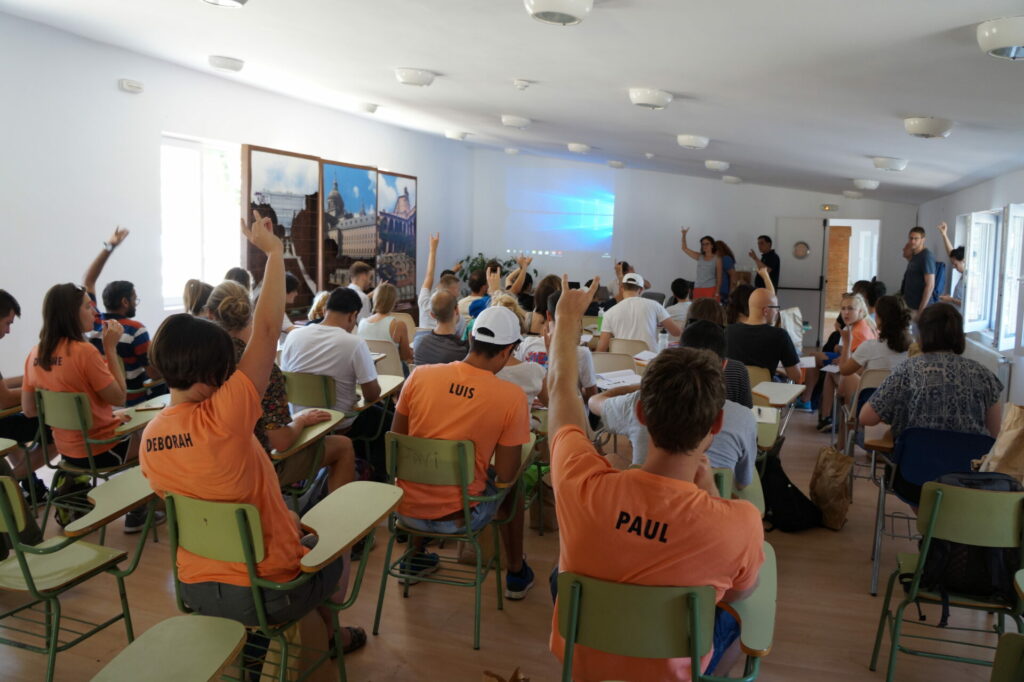
What my students do love is facilitated teamwork. They understand that it’s not fair if one of the people in the team is doing everything on their own, so they appreciate my tips on how to work together, such as by taking turns to speak, or setting agreements on who will do what, having roles such as meeting time-keeper. Of course not all teams get excellent collaboration at the first try, but I enjoy seeing them improve!
I asked Hannah what worked well for her as a teacher using facilitation in the classroom, and here are her insights—learned the hard way!
– Don’t do it alone. Find at least one other staff member who is interested in facilitation and help one another. Even better if you can get school management on board!
– Don’t do it all at once. Choose some simple facilitation activities to start with, especially at the beginning of the school year to help students know one another.
– Besides using facilitation in the classroom, consider that teachers have many meetings too! I’ve been working to introduce facilitation into staff meetings: this has beneficial effects that cascade, as more teachers get exposed to facilitation tools and ask me about them.
In closing
If you have some challenges around student engagement, difficult dynamics in the classroom, or want to make your lesson plans more memorable, facilitation might just be the secret ingredient you were missing!
As Hannah’s story shows, it’s a good idea to introduce facilitation into your lessons a bit at a time. Tools that help with forming a group are the easiest to begin with, and maybe this article has already given you some ideas on how to change your lesson plans with facilitation too!
SessionLab’s planner app can help you keep all your lessons well “sandwiched” and organized, adding activities directly from a 1000+ methods strong Library as well as saving one year’s classes to re-use the next.
Explore this collection of icebreaker games for students for some effective ways to open your session and get your class warmed up.
If you are a newcomer to the world of facilitation, you might want to check out our (free) email course Facilitation is for Everyone for more ideas and resources, as well as join our friendly Community, where you can share stories and ask any questions.
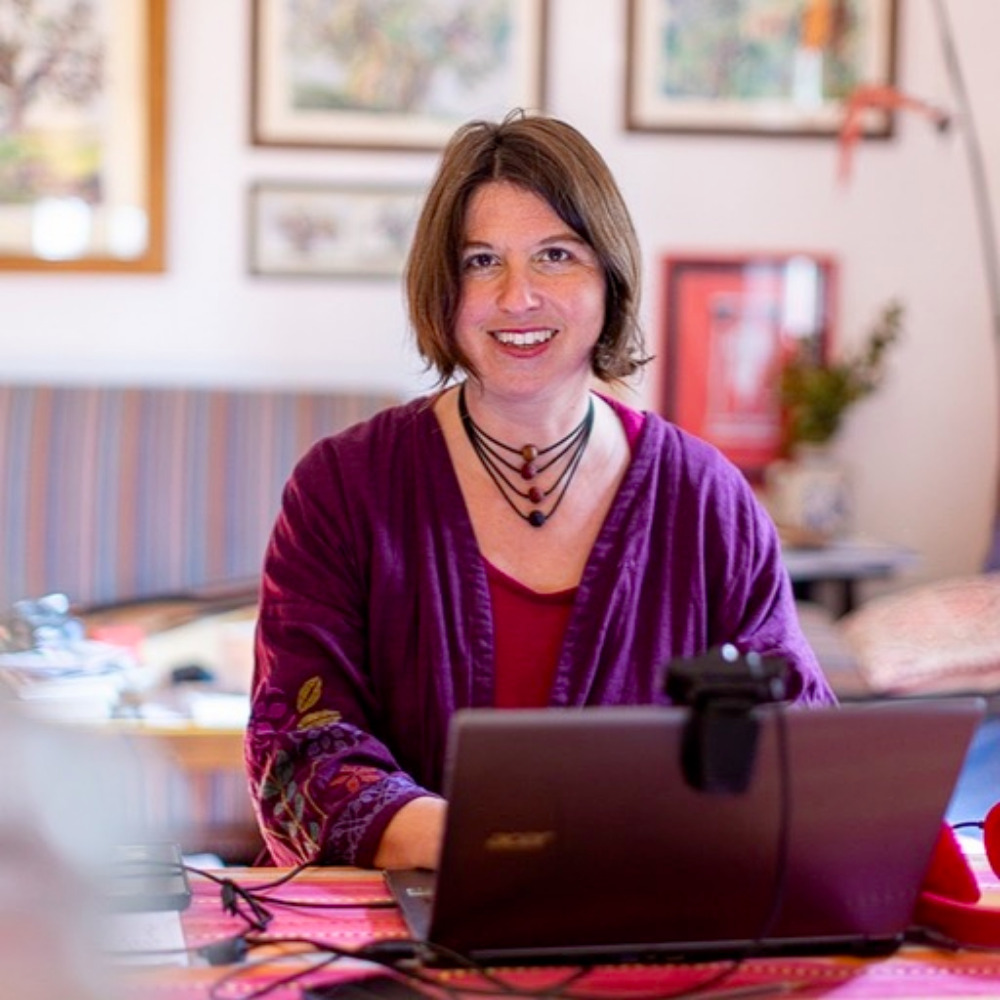



Leave a Comment